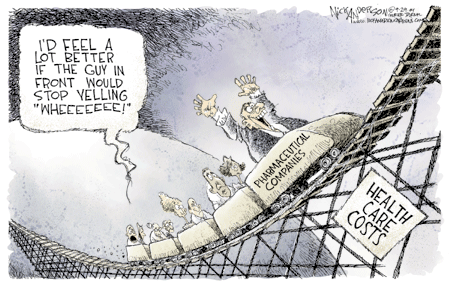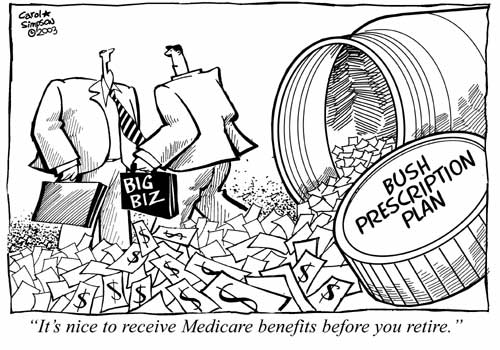 han
the energy and tobacco industries combined! Furthermore, between 1997 and 2000
the medical industry spent an additional $734 million lobbying the legislative
and executive branches.
han
the energy and tobacco industries combined! Furthermore, between 1997 and 2000
the medical industry spent an additional $734 million lobbying the legislative
and executive branches.The Business of Medicine:
George Bush meets Ronald Reagan
The healthcare crisis we face today has been grossly exacerbated
by the pro-business policies of George Bush, building on the critically misdirected
foundation laid by Ronald Reagan. By pandering to big business in policies and
appointments, the Bush administration has accelerated the crisis which, if unchecked,
promises to deny healthcare to even more millions of US citizens and drive record
numbers of others into bankruptcy or financial insolvency.
What Cost Healthcare?
Some say that we have the best health care system in the world, and that the
best doesn’t come cheap. Undeniably, we have the most expensive system:
last year, US citizens spent over $1.7 trillion dollars on their health care,
or roughly $6,000 per person. This is over twice what France, Greece and Germany
spend per capita.
| US Americans spend twice as much on health care as Europeans, but die younger. |
But is it the best system? Again, the answer is undeniable: No.
French, Greek and German citizens live years longer than US citizens. We pay
more than twice as much for a system that delivers less benefit, and leaves
millions without health coverage.
The Bush solution is to shift more and more costs away from the
government and onto businesses and private citizens. For example, Health Care
Savings Accounts will allow citizens to save money – if they can –
to spend on health care without paying taxes on it. However, this plan does
nothing to lower health care costs;
instead, it allows us to pay for healthcare with a slightly reduced tax burden.
This is hardly a solution to double-digit annual cost increases.
In 1960, healthcare spending in the United States was $27 billion;
by the end of the Reagan years it was $888 billion, an annual increase of 11%.
In 2001, healthcare spending was 14.1% of our gross domestic product; by 2012
it is expected to reach 17.7%, or $3.1 trillion.
US citizens continued to lose health insurance in 2003: a 13%
increase in uninsured people since 2000. After dipping throughout the late 1990s,
the total reached 16% of the population last year, or about 44 million adults
and children.
Service or Profit-Driven Enterprise?
According to Pulitzer Prize winning journalists Donald Barlett and James Steele,
the largest factor in the failure of our healthcare system is that it treats
medicine as a business, rather than as a necessary service. Placing a profit-making
industry (the insurance industry) between physicians and patients almost guarantees
that costs will soar. When you add two other profit-oriented systems –
the pharmaceutical companies and malpractice lawyers – it is no wonder
that we are rushing to chaos.
These industries lobby to keep government out of the process.
In the last 15 years, the medical industry contributed $479 million to political
campaigns, more t han
the energy and tobacco industries combined! Furthermore, between 1997 and 2000
the medical industry spent an additional $734 million lobbying the legislative
and executive branches.
han
the energy and tobacco industries combined! Furthermore, between 1997 and 2000
the medical industry spent an additional $734 million lobbying the legislative
and executive branches.
For them, it’s been money well spent: in 2001, retail prescription
sales grew over 22% to almost $54 billion. And Bush continues to block efforts
to allow US-made drugs to be imported from Canada – doubling our cost.
In 2003, Medicare’s head Thomas Scully – the former
president of the Federation of American Hospitals – helped craft the new
Medicare bill, which blocked imports of low-cost drugs from Canada and provided
billions of dollars in tax subsidies to private insurers to provide drug coverage.
At the same time, Scully was negotiating his return to the industry that would
benefit from the bill. Ten days after the bill was passed, Scully left the government
and joined a law firm and an investment banking system, each with a focus on
health care. (Source: Barlett and Steele)
Before he left, Scully withheld true estimates of the bill’s
cost – $550 billion over ten years – and instructed his staff to report
the cost as $400 billion. Immediately after the bill passed, the Bush administration
revised the estimates up to $534 billion.

Jim, a computer consultant to medical practices and hospitals, has a long-term family connection with SPC. He can be reached at <http://www.ignitionsys.com>.